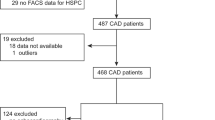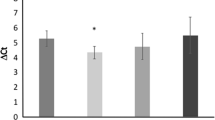Abstract
The number of circulating endothelial progenitor cells (EPCs) is considered to be a surrogate marker for coronary artery disease (CAD). Recent studies have identified a novel T-cell subset labeled with CD3+/CD31+, which is necessary for EPC colony formation and constitutes the central cluster. However, the clinical relevance of the CD3+/CD31+ T cells in CAD remains unclear. We sought to clarify whether circulating CD3+/CD31+ T cells are increased in patients with acute coronary syndrome (ACS). Circulating CD3+/CD31+ T cells were determined in 16 ACS patients undergoing emergency percutaneous coronary intervention (PCI) and in 16 control subjects with angiographically normal coronary arteries. Although no differences between the groups were found in baseline patient characteristics, the ratio of circulating CD3+/CD31+ T cells before PCI was higher in ACS patients as compared with that in control subjects (51.8 % ± 7.8 % vs 31.8 % ± 9.6 %, respectively; P < 0.001). The increased ratio of CD3+/CD31+ T cells in ACS patients was not altered 24 h after PCI, but became comparable with that in control subjects within 6 months after PCI. These results suggest that mobilization of CD3+/CD31+ T cells occurs in ACS, but is no longer detectable at 6 months after PCI.

Similar content being viewed by others
References
George J, Goldstein E, Abashidze S, Deutsch V, Shmilovich H, Finkelstein A, Herz I, Miller H, Keren G (2004) Circulating endothelial progenitor cells in patients with unstable angina: association with systemic inflammation. Eur Heart J 25:1003–1008
Massa M, Rosti V, Ferrario M, Campanelli R, Ramajoli I, Rosso R, De Ferrari GM, Ferlini M, Goffredo L, Bertoletti A, Klersy C, Pecci A, Moratti R, Tavazzi L (2005) Increased circulating hematopoietic and endothelial progenitor cells in the early phase of acute myocardial infarction. Blood 105:199–206
Hill JM, Zalos G, Halcox JP, Schenke WH, Waclawiw MA, Quyyumi AA, Finkel T (2003) Circulating endothelial progenitor cells, vascular function, and cardiovascular risk. N Engl J Med 348:593–600
Wang CH, Hsieh IC, Cherng WJ, Chen CC, Tung TH, Lee JF, Lin SJ, Wang PN (2012) Differentiation profile of peripheral blood-derived vascular progenitor cell predicts intimal hyperplasia after coronary stenting. Heart Vessels 27:10–19
Egan CG, Caporali F, Capecchi PL, Lazzerini PE, Pasini FL, Sorrentino V (2011) Levels of circulating CXCR4-positive cells are decreased and negatively correlated with risk factors in cardiac transplant recipients. Heart Vessels 26:258–266
Hur J, Yang HM, Yoon CH, Lee CS, Park KW, Kim JH, Kim TY, Kim JY, Kang HJ, Chae IH, Oh BH, Park YB, Kim HS (2007) Identification of a novel role of T cells in postnatal vasculogenesis: characterization of endothelial progenitor cell colonies. Circulation 116:1671–1682
Rouhl RP, Mertens AE, van Oostenbrugge RJ, Damoiseaux JG, Debrus-Palmans LL, Henskens LH, Kroon AA, de Leeuw PW, Lodder J, Tervaert JW (2012) Angiogenic T-cells and putative endothelial progenitor cells in hypertension-related cerebral small vessel disease. Stroke 43:256–258
Shintani S, Murohara T, Ikeda H, Ueno T, Honma T, Katoh A, Sasaki K, Shimada T, Oike Y, Imaizumi T (2001) Mobilization of endothelial progenitor cells in patients with acute myocardial infarction. Circulation 103:2776–2779
Adams V, Lenk K, Linke A, Lenz D, Erbs S, Sandri M, Tarnok A, Gielen S, Emmrich F, Schuler G, Hambrecht R (2004) Increase of circulating endothelial progenitor cells in patients with coronary artery disease after exercise-induced ischemia. Arterioscler Thromb Vasc Biol 24:684–690
Kim SW, Kim H, Cho HJ, Lee JU, Levit R, Yoon YS (2010) Human peripheral blood-derived CD31+ cells have robust angiogenic and vasculogenic properties and are effective for treating ischemic vascular disease. J Am Coll Cardiol 56:593–607
Abbott JD, Huang Y, Liu D, Hickey R, Krause DS, Giordano FJ (2004) Stromal cell-derived factor-1 alpha plays a critical role in stem cell recruitment to the heart after myocardial infarction but is not sufficient to induce homing in the absence of injury. Circulation 110:3300–3305
Guven H, Shepherd RM, Bach RG, Capoccia BJ, Link DC (2006) The number of endothelial progenitor cell colonies in the blood is increased in patients with angiographically significant coronary artery disease. J Am Coll Cardiol 48:1579–1587
Author information
Authors and Affiliations
Corresponding author
Rights and permissions
About this article
Cite this article
Kakizaki, M., Nobori, K., Watanabe, H. et al. Increased circulating CD3+/CD31+ T cells in patients with acute coronary syndrome. Heart Vessels 28, 566–569 (2013). https://doi.org/10.1007/s00380-012-0284-z
Received:
Accepted:
Published:
Issue Date:
DOI: https://doi.org/10.1007/s00380-012-0284-z




